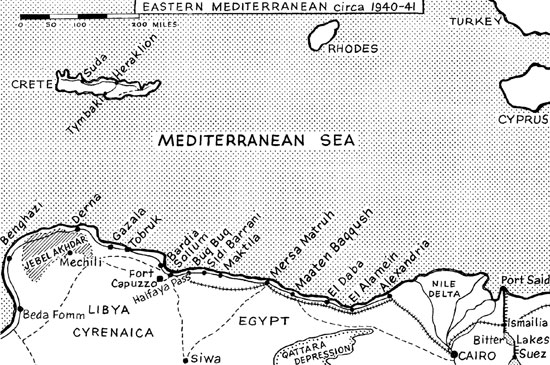The Middle East
Bardia
With the capture of everything between Nibeiwa to Sidi Barrani it had become obvious to Lieut-General O’Connor that Operation Compass had succeeded beyond his most optimistic hopes. Instead of regarding the operation as merely a raid, the situation called for the fullest possible exploitation. Unfortunately before first light on the 11th December he received an order to withdraw the two Indian brigades of 4th Indian Division plus all the divisional troops as quickly as possible for dispatch to Abyssinia. The fact that 16th British Infantry Brigade would stay with him was small consolation, since only one brigade of the newly arrived 6th Australian Division was immediately available.
The immediate task of 16 Brigade was the collection of salvage and control of POWS. The Italian officers seemed incompetent and selfish, taking little interest in their men, so the administration of the limited water and food available to the half-starved prisoners was a miserable job. The Western Desert Force had captured 38,300 Italian and Libyan POWS. Between the 12th-17th December the 2nd Queen’s had evacuated almost 5,000 and handed over a further 7,000 to a detachment of the 1st Durham Light Infantry.
On the 17th December 2nd Queen’s was ferried in MT to Sollum, the Egyptian frontier post which had been recaptured, together with Halfaya Pass to the south, by 7th Armoured Division the previous day. 16 Brigade was placed in reserve to the forces containing the small port of Bardia, which had a garrison of over 40,000 enemy troops. On the 19th December 16 Brigade moved up to gain contact with the southern portion of the Bardia defences, whilst the leading Australian brigade, also numbered the 16th, relieved the Support Group of 7th Armoured Division, enabling the whole of that division to be deployed farther north ready to deal with any enemy reinforcement from Tobruk. 2nd Queen’s, in fact, occupied the top of Halfaya Pass with its magnificent views of the sweep of Sollum Bay and the steep cliffs to the north leading on to Bardia. 2nd Leicesters held the advanced posts of the Brigade with the Carrier Platoon of 2nd Queen’s under command. Next day the Battalion moved north a couple of miles to the wadi of El Hasaiya, where to their surprise they found dug-outs and huts with the luxury of proper lavatories.
On the 21st December 16 Brigade came under command of the 6th Australian Division, and, on the morning of the 22nd, 2nd Queen’s went forward to relieve 2nd Leicesters in the front line. The line ran west from the coast about four miles north of Sollum to the frontier wire. The forward companies, ‘A’, ‘C’ and ‘D’ Companies, were about two miles from the southern Bardia defences. This position was held for nearly a week, and frequent patrols were sent out. The enemy line near the coast consisted of a formidable anti-tank ditch covered by numerous machine-guns manned day and night. A patrol of ‘A’ Company had a rough time in front of this position and three men failed to return. Farther to the west it looked as if the defences had not been completed, and several sections of the Battalion were detached to defend isolated artillery posts in the empty desert in this area. One of these sections was captured.
After Christmas a number of Australian officers of the 2/6th Battalion of the 17th Australian Infantry Brigade arrived for reconnaissance and introductory training, and were attached to the companies. They were enthusiastic but inexperienced, some never having seen a compass. On the night of the 28th 2nd Queen’s was relieved by the 2/6th Battalion and went back to Buq Buq for a short rest. Whilst at Buq Buq the missing men from the recent operations returned to the Battalion. The Italian ship in which they were being evacuated was intercepted by the destroyer HMAS Voyager, whereupon the prisoners overpowered their guards and took over the ship. On the 2nd January 16 Brigade marched back to Halfaya, and the Battalion occupied the same wadi which they had been in a fortnight earlier. The Brigade was held in reserve whilst the two brigades of the 6th Australian Division and 23 Matildas of the 7th Royal Tank Regiment attacked Bardia on the 3rd January. The attack was completely successful, and Bardia was finally cleared after three days of fighting.
On the morning of the 5th January 2nd Queen’s moved up to the town to provide local protection and guard POWS. Conditions were chaotic since there were large supplies of brandy in the town and the Australians had celebrated their first victory in no mean fashion. However, the next day the Australians moved west toward Tobruk and 16 Brigade were left in charge. The once pleasant little town was completely burnt out and its harbour was littered with sunken ships. ‘A’ and ‘D’ Companies found themselves dealing with 15,000 prisoners, and during the next few days 25,000 POWs in all were evacuated. The whole Battalion was then employed on guards and salvage until the 11th February, when they were ferried by MT to Sollum and there embarked for Alexandria. XIII Corps (as the Western Desert Force had been designated) had won an annihilating victory over the Italian Tenth Army at Beda Fomm beyond Benghazi, but to maintain that Corps of two divisions (7th Armoured and 6th Australian) on the borders of Tripolitania more than 500 miles across Cyrenaica required that all other formations must be sent back from the desert. Besides, the strategic emphasis had moved, for political reasons, towards a new ally, Greece.

Eastern Mediterranean, circa 1940-41.
« Previous ![]() Back to List
Back to List ![]() Next »
Next »
Related
